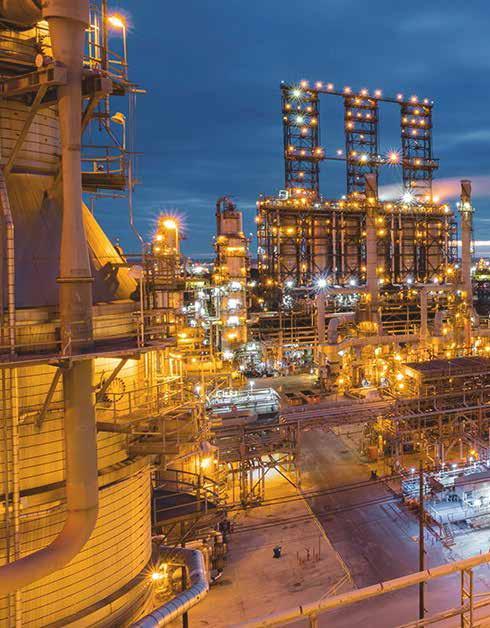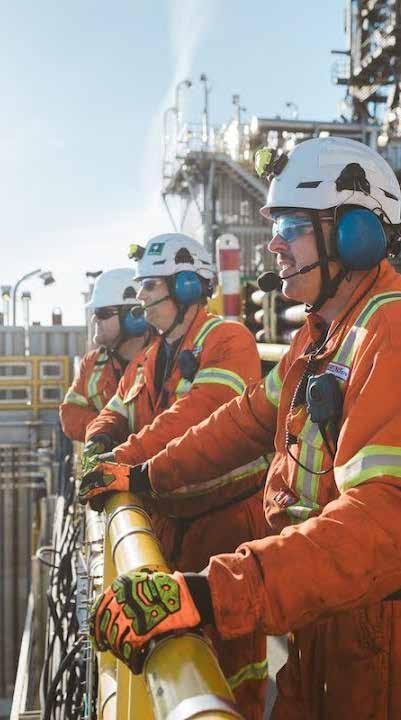
7 minute read
Energy Capital


The Refinery Paradox

How could North America still be a refining leader if it's shutting down one in five refineries by 2025?



By Energy Capital

Refining is still in the game
In a world increasingly focused on reducing emissions, is the future of downstream and refineries consistent? Even though in 2020 carbon emissions from the use of fossil fuels and the industry fell by 7% compared to 2019 levels, this year's greenhouse gas emissions generated by the transportation sector alone are expected to return to pre-pandemic levels, accounting for approximately 29% of total industry emissions in the United States.
Moreover, although the COVID-19 pandemic has negatively affected the market —delaying many refinery projects across the globe, and leading to more than 1 million b/d of US and Canadian refining capacity shut in 2020 —, increasing demand for petroleum products in the coming years, is expected to drive further the sector's growth. This matches a global refining capacity expected to grow at a CAGR of more than 1.25% during 2021-2026.
Indeed, the Energy Information Administration expects global consumption of petroleum and liquid fuels to average 97.7 million b/d for all of 2021, which is a 5.4 million b/d increase from 2020. By 2022, EIA similarly forecasts global consumption of petroleum and liquid fuels to increase by 3.6 million b/d to an average of 101.3 million b/d.
Additionally, refining investment is still underway. According to the International Energy Agency (IEA), refining investments have surged since 2015, with the exemption of 2020's numbers. In this sense, spending on new refinery builds and upgrades amounted to USD 52 billion in 2019.
The challenges
Even though some regions such as North America have advantages in terms of infrastructure and expertise, the refining market is finding several restraints. A lack of funds, delay in commissioning projects, and the increasing adoption of electric vehicles in developed nations are expected to significantly affect the market.
Accordingly, several energy agencies wonder what actions will leading downstream producers take to address this situation. The ways are many, including, for instance, closures, changes in the integration of value chains, and transitions towards new, more sustainable products, among other strategies.
This is particularly important considering that, in a forecasted scenario, one in five refineries will shut down over the next five years. Further, this picture is remarkably notorious for North America and Western Europe since, by 2030, one in three refineries will need to reassess its operating model. Indeed, calculations expect that about 1 million b/d of North American refining capacity will be shuttered shortly.
Worth noting, this is an interesting paradox because even though several refineries are shutting down



in North America, the total refining capacity in the US, for instance, continues to expand
In this regard, we can wonder how will the refineries of the future, particularly in North America, likely look? What current elements will let them overcome the challenges the market is posing to them? Will they remain as market leaders even in a highly competitive and changing environment?
North American Refineries – the differentiators
When we look at the refining progress in North America, we can identify the high degree of difficulty involved in the industry. We see strong producers been resurgent through the energy revolution and, despite all the challenges, still striving to maintain their global leadership.
To keep this pace, technical excellence has been essential, along with the shale revolution's advantages and a boost coming from policy. It is worth noting that US refiners are among the most sophisticated globally, benefiting from operating in the world's largest oilconsuming nation.
As some experts note, North America, overall, can upgrade and produce lots of highly marketable gasoline and diesel fuel, with very few byproducts. Moreover, the region produces almost all types of gasoline, diesel, and jet fuel, to meet approximately 60% of demand globally.
Indeed, according to ENI World Oil Review 2020, North American —predominantly the US — refiners, on average, are significantly more complex than their counterparts in Europe and Asia. In addition, US refiners are highly adaptive to changing market circumstances.
Moreover, a boost from policy considerably contributed to North America's refining profitability. Simultaneously, between 2000 and 2019, US refining capacity and throughput increased substantially (+2.4 and +1.5 million b/d, respectively). Consequently, over that period, the US moved from being one of the largest net importers of refined products globally to being one of the largest net exporters.
Remarkably, North American refiners experienced a sharply different trend compared to refiners in other industrialized countries. For instance, capacity and throughput in the European Union each fell by 1.6 million b/d over the same period, and Japanese refiners suffered even more significant declines in percentage terms.
To these advantages adds the refining integration scheme. For instance, refiners on the west coast emphasized the right location (Alaska) and upgrades (California). For Gulf Coast refineries, producers wellunderstood conversion capability as a prerequisite of crude slate flexibility. On the east coast of North America, refiners favored downstream integration where there was proximity to crude and a large retail market. Lastly, Central

Canada and mid-America leveraged on an excellent combination of pipeline access to Western-Canadian crude and limited product competition. Prompted by growing exploration in Canada's oil sands, some refineries in the region also improved their processing capability toward heavier crudes.
What's changing the scene?
Shrinking gasoline demand has significantly impacted refiners within the United States. Moreover, refineries on the North American east coast are vulnerable to declining demand for gasoline, the highly unfavorable WTI-Brent spread, and the competition from overcapacity in Europe and coming infrastructure additions in the Asia Pacific, Middle East and Africa. Moreover, under a new US administration, refineries themselves are likely to face a more challenging policy environment, particularly as emissions of CO2 meet stricter regulation. This trend will add to the significant shutdowns and sales the industry is seeing.
The Asia Pacific region is expected to witness the highest crude distillation unit (CDU) capacity additions globally by 2025, contributing about 48% of the total global CDU capacity additions. Similarly, the Middle East will be the second-highest contributor to the global CDU capacity additions and Africa the third. This can be better understood if we consider that oil consumption continues to rise in developing markets and fall (or remain static) in developed countries.
Similarly, the conventional wisdom of vertical integration as the ideal model for refiners is being challenged. When we talk about vertical integration,
we refer to a company's ability to capture value by making the most advantages across the entire value chain. In this regard, North America has seen a significant shift with respect to conventional vertical integration wisdom. Accordingly, several companies, including BP, Sunoco, ConocoPhillips, and Marathon, recently ran into separate upstream and downstream companies.
Where are the opportunities now?
According to global energy agencies, the competitive refineries of the future in North America will be complex facilities with a solid bend for petrochemicals or repurposed activities, including biofuels or biodiesel production. Indeed, that's precisely what's already happening in the industry.
For instance, in March this year, North America's largest refiner Marathon Petroleum announced its plans to convert and repurpose its Martinez, California, refinery into a renewable fuels manufacturing facility; the move was approved by its Board of Directors. Similarly, Marathon has a 12,000 b/d renewable diesel (RD) plant in Dickinson, North Dakota, which began production in the first quarter of 2021. Lastly, the company completed in May the sale of its convenience store arm, Speedway, to 7-Eleven.
Marathon is not the only North American refiner adjusting its growth plans. Similarly, Valero Energy announced that it will spend 40% of its $2 billion 2021 capital spending on growth projects and half of that on renewable diesel growth. Indeed, the company shared that this was the only segment that posted positive earnings in the first quarter.
Accordingly, the company is working through Diamond Green Diesel, its joint venture with Darling Ingredients, Inc., to build the DGD III located at Valero's Port Arthur, Texas, refinery. This facility is expected to be online in the second half of 2023 and produce 470 million gal/year of renewable diesel. Other North American refiners addressing the energy transition and changing market conditions with similar strategies are Phillips 66, ExxonMobil, Chevron, among others.
In resume, there is only one certainty surrounding the evolving refining market in North America and globally: companies must be adaptative and deliver over-the-top solutions. Although the upscaling in global refining will mainly result in divestment and closure of lagging assets in the region, refiners are well fitted to repurpose or start building facilities to deliver more advanced fuels. As a result, North America can still be a refining leader, following its understanding that things must change to advance.











